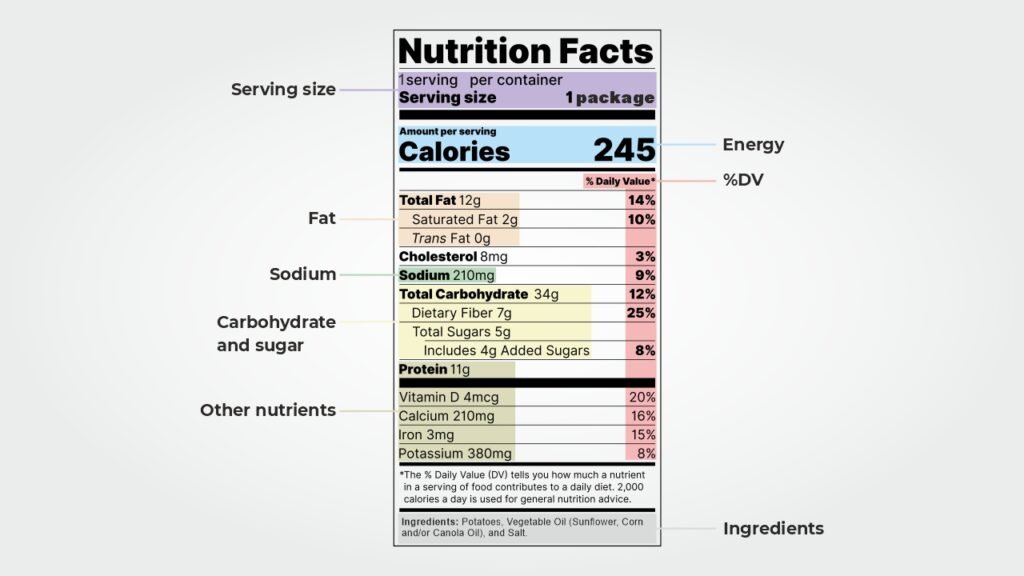Decoding Food Labels for Informed Choices
Food labels are indispensable tools for consumers, acting as a window into the nutritional composition and safety of what we eat. They empower individuals to make well-informed decisions about their diet, catering to various needs from managing health conditions to adhering to specific dietary preferences. Beyond merely listing ingredients, these labels offer critical insights, including nutritional data, allergen warnings, and serving recommendations, all designed to foster greater transparency in our food choices [Source: FDA].
Navigating the Nutrition Facts Panel
At the core of food labeling lies the Nutrition Facts panel, a standardized component meticulously regulated by the U.S. Food and Drug Administration (FDA) [Source: FDA]. This panel is a treasure trove of information, highlighting essential details such as serving size, calorie content, and the breakdown of fats (total, saturated, and trans), cholesterol, and sodium. It also details total carbohydrates, dietary fiber, total sugars, and critically, added sugars, alongside protein content and select vitamins and minerals [Source: FDA].
A common pitfall for consumers is overlooking the serving size. The nutritional values presented on the label are almost always per single serving, meaning that a package often contains multiple servings. For instance, a bag of chips might list 150 calories per serving, but if the bag contains two servings, consuming the entire bag doubles that caloric intake to 300 calories [Source: American Heart Association]. Therefore, understanding and adjusting for serving size is paramount for accurately tracking your intake of calories and other nutrients.
Furthermore, the Nutrition Facts panel also includes Daily Values (DVs), which are reference amounts of nutrients to consume or not to exceed each day. These are often presented as percentages (%DV) and can help you determine if a serving of food contributes a little or a lot to your daily diet for each nutrient. A 5% DV or less for a nutrient indicates a low amount, while a 20% DV or more signifies a high amount [Source: FDA – Understanding the Nutrition Facts Label]. For instance, if you’re monitoring sodium intake, aiming for foods with a low %DV for sodium can help you stay within recommended limits. Conversely, for nutrients like fiber or certain vitamins, a higher %DV is generally beneficial.
Unpacking the Ingredients List
The ingredients list offers a comprehensive and transparent look into the components of a food product, presented in descending order by weight. This means the ingredient listed first is the most abundant in the product, while the last ingredient is present in the smallest quantity [Source: FDA]. This order is crucial for consumers who want to identify primary components or avoid specific substances. For example, if “sugar” or a form of it (like high-fructose corn syrup) is among the first few ingredients, it indicates a high sugar content.
This section is particularly vital for individuals with food allergies or sensitivities. The Food Allergen Labeling and Consumer Protection Act of 2004 (FALCPA) mandates that labels clearly declare the presence of major food allergens, which include milk, eggs, peanuts, tree nuts (such as almonds, walnuts, and pecans), soy, wheat, fish, and shellfish [Source: FDA – FALCPA]. These allergens must be listed in plain language, often immediately following or within the ingredients list. This clear declaration helps prevent accidental exposure, which can range from mild discomfort to severe, life-threatening reactions. Beyond the “Top 8” allergens, some individuals may have sensitivities to other ingredients, making a careful review of the entire list essential. Consumers should also be aware of “Contains” statements or “May Contain” advisories for cross-contamination risks, although the latter is voluntary.
The ingredients list also reveals the degree of processing a food has undergone. Products with a long list of unfamiliar or artificial-sounding ingredients often indicate a higher level of processing, which might suggest fewer whole, natural components. Opting for foods with shorter ingredient lists, composed of recognizable whole foods, can be a simple strategy for healthier eating.
Deconstructing Marketing Claims
Beyond the factual data on the Nutrition Facts panel and ingredients list, food labels often feature various marketing claims designed to attract consumers. Terms such as “low-fat,” “light,” “organic,” “sugar-free,” “natural,” and “gluten-free” are common, but it’s important to understand that these are not merely advertising jargon. Many of these terms have specific regulatory definitions set by the FDA, ensuring a degree of consistency and preventing outright deception [Source: FDA – Label Claims].
For example, a product can only be labeled “low sodium” if it contains 140 milligrams (mg) or less of sodium per serving [Source: FDA – Label Claims]. Similarly, a “fat-free” product must contain less than 0.5 grams of fat per serving, while “low-fat” means 3 grams or less of fat per serving. The term “organic” is regulated by the USDA, requiring products to meet strict standards regarding how they are grown and processed, avoiding synthetic pesticides, fertilizers, and GMOs. “Sugar-free” products must contain less than 0.5 grams of sugar per serving.
However, consumers must exercise discernment. A “low-fat” product might be high in sugar to compensate for flavor, or a “gluten-free” product might still be high in calories, unhealthy fats, or refined starches. The term “natural” is particularly tricky as it lacks a formal, binding definition from the FDA beyond not containing artificial ingredients or colors and being minimally processed. This allows for a broad interpretation that can sometimes be misleading.
Therefore, understanding these regulatory definitions is crucial for differentiating genuine health benefits from marketing ploys. When making purchasing decisions, it is always beneficial to look beyond catchy claims and delve into the Nutrition Facts panel and ingredients list. Comparing similar products side-by-side, focusing on their actual nutrient content and ingredient quality, is the most effective way to select options that truly align with your dietary goals and health priorities.
Sources
- American Heart Association – How to Understand and Use the Nutrition Facts Label
- FDA – Food Allergen Labeling and Consumer Protection Act of 2004 (FALCPA)
- FDA – How to Understand and Use the Nutrition Facts Label
- FDA – Label Claims for Food Labeling
- FDA – Official Website
- FDA – Understanding the Nutrition Facts Label
Conclusion:
Food labels provide vital information on nutrition, ingredients, and allergens, empowering consumers to make informed dietary choices [FDA]. The Nutrition Facts panel details serving sizes, calories, and % Daily Values, helping track nutrient intake accurately [AHA, FDA]. Ingredients lists, arranged by weight, reveal key components, allergens, and processing levels, aiding those with sensitivities [FDA – FALCPA]. Marketing claims like “low-fat,” “organic,” or “sugar-free” have regulatory definitions, but careful label reading is essential to distinguish genuine benefits from misleading promotions [FDA].




